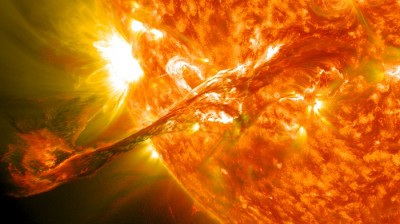
Image source: NASA
A severe solar storm with the potential to disrupt wireless communications, GPS and the electric power grid took scientists by surprise on St. Patrick’s Day – and has experts worried because the federal government’s Space Weather Prediction Center (SWPC) did not anticipate it.
“Our models showed we were just going to receive a glancing blow from this cloud coming off the sun,” Thomas Berger, the SPWC’s director, acknowledged in an interview with The Baltimore Sun. “We are now thinking we caught more than just a glancing blow.”
No major disruptions to communications, GPS or electricity were reported, but some minor fluctuations did occur on Tuesday afternoon, The Washington Post reported. The solar or geomagnetic storm has scientists concerned because its behavior did not match the models they use to predict such events.
On Sunday, the SPWC had predicted a storm would hit but expected it to be much weaker than it actually was. Berger’s team was taken by surprise when the storm intensified and arrived 15 hours earlier than expected on Tuesday. The storm lasted about 12 hours with lingering effects for 24 hours.
World’s Smallest Solar Generator … Priced So Low Anyone Can Afford It!
“This is still an inexact science and it’s difficult to gauge what the impacts will be,” Berger said.
History Shows It Will Happen Again
Some experts believe solar storms pose the greatest threat to the American power grid. A 1989 solar storm caused a widespread blackout in Quebec, and an even greater storm in 1921 knocked out the entire signal and switching system of the New York Central Railroad. The greatest solar storm on record, the Carrington Event in 1859, destroyed parts of the American telegraph system. It is believed that if an 1859-type of solar storm happened today, much if not all of the US would suffer a blackout.
A Carrington Event is a level G5 solar storm; the St. Patrick’s Day event was a level G4 outburst.
The latest episode is significant because it shows that scientists cannot always predict the severity of storms. For years, it was believed that scientists would be able to predict a catastrophic solar storm, if one were heading toward earth.
The major effect of the St. Patrick’s Day Solar Storm was to create an unusually bright display of the Northern Lights or Aurora Borealis in the atmosphere in the northern hemisphere, including some parts of the U.S. – such as Nebraska and Massachusetts – that rarely see them.
What Is A Solar Storm?
A solar storm occurs when a solar flare creates a burst of charged particles from the sun. When the particles reach Earth, they can put a massive amount of electricity into the atmosphere that can overwhelm power grids and disrupt some communication systems, including GPS. One effect of such storms is to energize oxygen atoms which turn the atmosphere green and create Northern Lights.
The US government is so worried about solar storms that NASA is launching a new generation of satellites and space probes to study the phenomenon. The SWPC, which is run by the National Weather Service and the National Oceanographic and Atmospheric Administration, says the satellites will help it track solar winds and solar storms and predict future solar storms.
The hope is that a new NASA satellite called Deep Space Climate Observatory or DSCOVR will serve as an alarm system for approaching solar storms and give the world advanced warning, The Sun reported. The current satellite doing that job, the Advanced Composition Explorer or ACE, is not designed to observe solar storms.
“The big mystery for us is why solar winds accelerate,” NASA scientist Nicky Fox told The Sun. “There are future missions that are going to provide us a lot of data that will help these [space weather forecasters] improve their models.”
What do you believe is the greatest threat to the power grid? Share your thoughts in the section below:
 Off The Grid News Better Ideas For Off The Grid Living
Off The Grid News Better Ideas For Off The Grid Living



